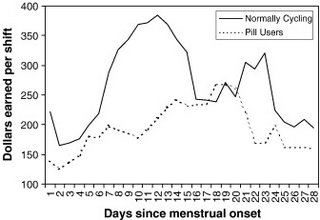|
Sunday, September 30, 2007
 The role of biology in constraining/enabling human culture is largely underappreciated outside of, well, the small group of people who study biology and culture. But that role is clearly enormous. Consider, for example, what is sometimes referred to as "cryptic ovulation"-- the fact that human females do not conspicuously display the fact that they are ovulating. In many other primates, the females have a patch of hairless skin that, as ovulation approaches, swells up bright red (see the picture of this in a baboon), signaling that she is fertile and driving the males a little crazy. Humans clearly do not do this, and I don't think it's an exaggeration to claim this was a biological prerequisite (or as close as you can get to one) for today's mixed-gender offices and the large-scale incorporation of women into the workforce. The role of biology in constraining/enabling human culture is largely underappreciated outside of, well, the small group of people who study biology and culture. But that role is clearly enormous. Consider, for example, what is sometimes referred to as "cryptic ovulation"-- the fact that human females do not conspicuously display the fact that they are ovulating. In many other primates, the females have a patch of hairless skin that, as ovulation approaches, swells up bright red (see the picture of this in a baboon), signaling that she is fertile and driving the males a little crazy. Humans clearly do not do this, and I don't think it's an exaggeration to claim this was a biological prerequisite (or as close as you can get to one) for today's mixed-gender offices and the large-scale incorporation of women into the workforce. But how cryptic is the human cryptic ovulation? Women are generally aware of where they are in their cycle, and men with long-term girlfriends/wives have probably noted subtle physiological changes (in breast size, for example) that correspond to their partner's hormonal fluctuations. Is this a subtler version of the sexual swelling in other primates? There is some evidence that this is the case, but Geoff Miller and colleagues take a rather novel approach to the question:  To see whether estrus was really "lost" during human evolution (as researchers often claim), we examined ovulatory cycle effects on tip earnings by professional lap dancers working in gentlemen's clubs. Eighteen dancers recorded their menstrual periods, work shifts, and tip earnings for 60 days on a study web siteThis is a nice way at getting around subjective measures of "attractiveness" in studies like this-- the amount of money made by a stripper probably corresponds pretty well to how physically attractive the males in the audience find her. And as seen in the graph on the right, there's a noticeable peak in earnings among normally-cycling women at around 10 days (ovulation). The sample size is small, of course, but the effect is consistent with other evidence than human females modulate their physical appearance and behavior according to the menstrual cycle, so I'm inclined to believe it. And needless to say, if this is the case, it suggests a rather simple profit-maximizing strategy for the professional lap dancer. Labels: Evolutionary Psychology |



